Got questions about labeling or organizing your plants? We’re here to help. Enjoy our blog “Metal to the Petal” to find ideas, images and answers as you keep your garden organized. We invite you to comment and share!
6 Benefits of Gardening With Your Kids
Many of the Benefits of Gardening Last Well Into Adulthood
 What if there was a magic fruit snack that would teach your kids math and science, help you bond over vibrant shared family experiences and, best yet, get your kids to love their veggies? There is no magic fruit snack, of course, but the benefits of gardening pack in all these great elements and more. When your child plucks their first cherry tomato from a plant they put in the ground and pops it right in their mouth, you may decide it’s a magic fruit snack.
What if there was a magic fruit snack that would teach your kids math and science, help you bond over vibrant shared family experiences and, best yet, get your kids to love their veggies? There is no magic fruit snack, of course, but the benefits of gardening pack in all these great elements and more. When your child plucks their first cherry tomato from a plant they put in the ground and pops it right in their mouth, you may decide it’s a magic fruit snack.
Beginning a garden with a young child may take some time and work, but there are six benefits of gardening that will make any effort you put in well worth it:
- Your kids might just eat their veggies. Kids love to help choose the plants they’ll grow in their garden, dig their little fingers into the dirt and help pull weeds. And just wait until the day you hand them the garden hose to handle the watering. After weeks of working in the garden, they’ll be so proud to pick lettuce or grab a few tomatoes for your salad. Try to not let your mouth hang open when they gobble up that salad.
- It engages all the senses. You might be hard-pressed to find an activity that so fully engages your kids. The smell of the soil and the flowers, the sound of fruit being picked off a vine, the sight of food ripening right in their backyard and the taste of those homegrown veggies all make gardening a vibrant activity for kids.
- Your kids learn about persistence and discipline. Gardening isn’t a one-day project. Regular weeding and watering helps kids see the results of a project that extends over weeks and months. Even if they lose interest after the initial planting, be sure to say that you’re going out to tend the garden and invite them to come and play near you while you work. You’ll model for them the dedication that a long-term project requires.
- Gardening enhances fine motor skills. Your child will work on some of their most critical fine motor skills when handling tiny seeds, scooping dirt around the plant and pulling tiny weeds.
- It teaches math and science. From introductory botany to basic math concepts, gardening is a great little school. Have your kids help you figure out how many plants you can fit on a row or talk through why you’re planting in an area that gets sun. You can also talk about why flowers appear before you’ll see fruit, or why it’s good to see worms and bees around your garden. There are so many ways to teach your kids while your garden.
- You’ll create memories. Your kids may be too small to have lasting memories of the first time they put their fingers into the dirt to make a spot for a seed, but you’ll treasure the moments you spend together for years to come. If you keep at it, year after year, gardening will be a vibrant part of your kids’ memories of childhood.
If you’re staring at a mountain of laundry, a sink full of dishes and two or three small faces wanting your attention, the thought of adding a garden to your plans may seem unrealistic. Start with one pot of geraniums or a big tub with one tomato plant and you’ll reap the same benefits of gardening with your kids.
To teach your kids the benefits of a well-organized garden, invest in a set of Kincaid Plant Markers. Made for a lifetime of gardening, they’ll be part of making memories with your kids as you use them year after year.
Identifying Trees for a Shaded Yard
When Identifying Trees, Balance Growth Rate With Hardiness
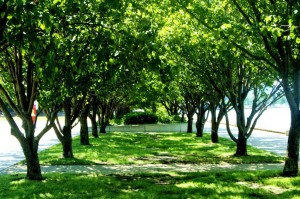 When identifying trees for introducing shade into your yard, it’s tempting to head straight for a fast-growing variety, such as a silver maple. The trouble with these trees is that, while they may provide shade relatively soon, you may soon lose that shade to a spring thunderstorm or a windy day. Fast-growing trees don’t come with the hardiness you need to enjoy them year after year.
When identifying trees for introducing shade into your yard, it’s tempting to head straight for a fast-growing variety, such as a silver maple. The trouble with these trees is that, while they may provide shade relatively soon, you may soon lose that shade to a spring thunderstorm or a windy day. Fast-growing trees don’t come with the hardiness you need to enjoy them year after year.
It’s better to balance growth speed with hardiness when identifying trees that are best for your yard. First, it might be a good idea to shift your expectations to sitting in the shade of your tree in five to six years, with a growth pace of about two feet per year, maximum. Here are a few options:
Shade trees are deciduous and can grow to more than 50 feet, which is perfect for shading the average size yard. A northern red oak is a good choice for Zones 5-9, but it prefers moist, well-drained and acidic soil. Another option is the Freeman maple, which will treat you to a beautiful red-orange show in the fall. It’s ideal for Zones 4-7 and can grow to heights of 75 to 80 feet. It grows best in full sun and moist, well-drained soil.
The tulip tree is another tall beauty, rising to heights of 75 to 90 feet and spanning 40 to 50 feet wide. It thrives in Zones 5-9 and provides beautiful chartreuse tulip-shaped flowers in the spring, while turning yellow in the fall.
Screening trees can also be a nice way to define the boundaries of your yard, shield your backyard activities from view and offer protection from wind. Depending on the spread of the species you choose, you can plant them in groups, rows or alone.
Try the dawn redwood, particularly if you live in Zones 5-10. It grows in a pyramid shape and features deciduous green needles with a feathery feel. It can grow up to 100 feet tall, and up to 25 feet wide. Provide it with full sun, slightly acidic soil and it should grow well.
The European black adler is a great choice for bordering a pond or another wet area. It reaches a height of 40 to 60 feet and is generally 20 to 40 feet wide. It grows well in Zones 3-7 and provides wet soil, but full sun.
The green giant arborvitae is a classic screening tree that can grow up to three feet each year. It will reach a maximum height for 50 to 60 feet and will be 12 to 20 feet wide. It needs no shearing, but makes a nice hedge for a yard border.
Identifying trees for a shade yard often means sacrificing fast growth for the benefits of sturdier varieties. Be sure to identify your trees with Kincaid Plant Markers, so that as they grow, year after year, you’ll be able to give them individualized care. Take a look at our selection of plant markers, each made for a lifetime of gardening.
The Perfect Gardening Gifts for Mother’s Day
Find Gardening Gifts for Every Budget
 Falling right in the middle of spring, Mother’s Day is a perfect time to invest in a few gardening gifts for your mom. If she’s a gardener, you’ll have the enjoyment of seeing her get use out of her gifts right away, and she’ll appreciate that you’ve honored a hobby that’s important to her. Even if she seemingly has every gardening tool ever conceived, you’re likely to find a suggestion on this list that will please your mother:
Falling right in the middle of spring, Mother’s Day is a perfect time to invest in a few gardening gifts for your mom. If she’s a gardener, you’ll have the enjoyment of seeing her get use out of her gifts right away, and she’ll appreciate that you’ve honored a hobby that’s important to her. Even if she seemingly has every gardening tool ever conceived, you’re likely to find a suggestion on this list that will please your mother:
Getting the job done…in style: A separate set of clothes for digging in the dirt is a way to introduce a touch of luxury into your mother’s gardening. Purchase lightweight items that add UV protection and can be tossed into the washer after a long day of planting or weeding. Don’t forget to add a coordinating floppy hat to protect her face from the sun.
For the rose lover: If your mom’s specialty is roses, you can find some gardening gifts that are ideal for her work. Try a pair of well-made rubber-coated gloves, perfect for handling and pruning thorny stems. You could also invest in a thorn remover that makes it easy for her to give her roses to others as gifts.
Make gardening easier on her body: Gardening is hard work, so look for tools that ease the strain. Even if it seems like she owns every kind of gardening trowel ever made, consider purchasing one for her that has a gel handle or other ergonomic design features. You can also purchase a combination kneeler and seat that helps her cushion her joints while working.
Get the kids involved: If your mom is also Grandma, you’ve got a perfect opportunity for thoughtful gardening gifts. Use a kit to create a handprint stepping stone of all her grandkids’ hands, or have them paint a special flower pot for display on her porch. Add her favorite flowers and have the kids help plant them.
The right equipment: If you’d like to spoil your mom this year, consider getting her a composter for her backyard, or a classic wooden gardening cart for transporting her plants and tools around the garden. A large basket for storing a garden hose also adds to the beauty of her yard. Investing in plant markers is also a great way to enhance her enjoyment of her garden. Year after year, she can use her plant markers to help her remember where she planted each kind of veggie and flower.
Get technical: If your mom is not only into gardening, but also the latest tech, think about a gift that combines her interests. There are seed heating mats that speed up germination, watering cans that increase the level of oxygen reaching the plants and digital thermometers that monitor outdoor conditions.
To learn more about the ideal gardening gift, Kincaid Plant Markers, visit our product page. Your mom will love the organization and style that our plant markers bring to her garden. Buy her a set for Mother’s Day!
Make Gardening at Home Fun With a Pizza Garden
Get Kids Gardening at Home With a Family Project
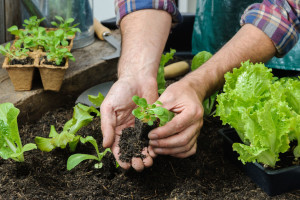 Planting a pizza garden is a great way to get kids enthusiastic about gardening at home. You’ll enjoy the ease of a mini vegetable garden and the plants you grow will also stretch for including in other recipes.
Planting a pizza garden is a great way to get kids enthusiastic about gardening at home. You’ll enjoy the ease of a mini vegetable garden and the plants you grow will also stretch for including in other recipes.
Consider beginning this project with a “pizza planting party,” by working together as a family to plant your garden and then celebrating with a homemade pizza that includes some of the ingredients you’ll plant to harvest from your pizza garden. Here’s how you get started:
Mark your pizza garden: Gardening at home always begins with planning, but this one is easy, because you’re about to plant your pizza garden in the shape of a pizza, with one ingredient in each of six or eight “slices.” Choose a six-foot or eight-foot square area that will receive six-to-eight hours of sun each day. Mark the center of your garden area, and then use a mallet to drive a small stake into the center of your garden area. Using a string tied to the stake, mark the border of a circle around your garden area.
Use rocks to mark the perimeter of your circle, and then mark your “slices” that will separate each area for planting. Turn your soil to about one foot of depth and mix in some organic mulch and manure to ensure healthy growth of your pizza ingredients.
Plant your veggies: Ideally, you’ll plant three herbs and three vegetables in your pizza. Oregano, basil and parsley are all good choices for herbs, and in your veggie section you can plant onions, tomatoes and peppers. For each herb and your peppers, you can include two to three plants in your wedge. Onions can be planted closely, and then you’ll want only one tomato plant in that space that you have.
Choose peppers according to your tastes. Maybe you’d like one bell pepper plant and then a hotter variety for a little extra spice. When it comes to tomatoes, choose Roma or another variety of paste tomato. It’s easy to make sauce from Roma tomatoes with a little olive oil, garlic, oregano and basil.
Have some fun: Gardening at home with kids requires a little patience, but you can also have a lot of fun. Besides the joy of playing in the dirt, kids can also decorate their pizza garden. Scatter some straw to look like mozzarella cheese, and then place a few small terra cotta planters on your “pizza” to look like pepperoni.
You’ll enjoy harvesting your pizza ingredients and your kids will love inviting friends over for pizza made from ingredients they grew themselves.
Help make gardening at home a success with an organized pizza garden. Include Kincaid Plant Markers in your pizza garden to give each of your ingredients the care they need to thrive. Take a look at the high-quality products we offer!
Gardening Tips for Succession Planting
These Gardening Tips Will Have Vegetables on Your Table Throughout the Season
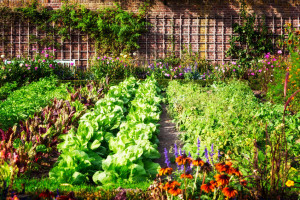 If you would like to enjoy vegetables from your garden every day of the year, rather than being flooded by one large harvest in late summer and fall, you may want to try succession planting. There are a few gardening tips that can help you get organized with a plan to make the most of your plot this year:
If you would like to enjoy vegetables from your garden every day of the year, rather than being flooded by one large harvest in late summer and fall, you may want to try succession planting. There are a few gardening tips that can help you get organized with a plan to make the most of your plot this year:
Think about the vegetables you enjoy, and gather some information. Seed packets and catalog descriptions provide helpful information about frost tolerance, when to plant, how many days it will take the plant to reach maturity and the average size of plants. Make a few notes about the plants you hope to grow this season and their relative growing times.
Create a few diagrams. Consider making a few drawings of your garden, one each for spring, summer and fall. You can organize your plants based on how fast they grow. Some varieties, such as peppers and tomatoes will harvest for several weeks, while other plants require a long growing time with one big harvest at the end, such as squash, corn and Brussels sprouts. Other vegetables, such as carrots, can be sown in early spring and then again in late summer for two good harvests in summer and fall.
You can also plan for some rows of lettuce that you’ll sow weekly to enjoy fresh salad on your table every night, rather than one big flood of lettuce that you’ll struggle to eat before it goes limp.
Consider roots and growth height. When planning your succession, one of the more strategic gardening tips is to include the root spread and growth height of preferred plants into your planning. You can pack more vegetables into your garden if they are organized well according to root structure and the height of your plants. You won’t want to plant corn, for instance, next to a shorter plant that will miss out on necessary sun exposure.
Think about your canning needs. Do you plan to can or freeze some of your bounty? It makes good sense to plant a few varieties that have one big harvest so that you can efficiently plan your canning schedule and get some vegetables put away for winter. These include indeterminate tomatoes, bush beans and some varieties of broccoli.
Do some research on your climate. You may be able to grow more into late fall and even through winter if you live in the right climate. Tame winters allow for peas, cabbage, kale and a host of other plants to be harvested throughout the winter months, and warm climates are great for growing melons and eggplant in the summers.
Succession planting can be a bit of a puzzle, so one of the best gardening tips is to get organized with Kincaid Plant Markers. Made for a lifetime of gardening, these markers will help you manage a strategy for keeping fresh vegetables on your table all year long. Be sure to visit our product page for more information.
Landscaping Ideas to Make Your Home Inviting
Adding Flowers to Your Landscaping Ideas
 Spring is just around the corner, and it’s time to think about landscaping ideas that will make your home an inviting destination for friends, neighbors and family. Whether you’re planning a few intimate dinners or a backyard party, sprucing up the beds around your home will make it more fun to throw open your doors for company.
Spring is just around the corner, and it’s time to think about landscaping ideas that will make your home an inviting destination for friends, neighbors and family. Whether you’re planning a few intimate dinners or a backyard party, sprucing up the beds around your home will make it more fun to throw open your doors for company.
Add a low fence to a small yard. If you live in an urban area and have a short front lawn, consider putting a low fence in front to define your yard. Surprisingly, it makes your yard appear more spacious and provides a frame for your home’s exterior.
Incorporate vines for beauty. Nothing makes a home look more lovely than flowering vines. Whether they’re climbing up an archway or across a low fence, these plants can soften the lines of your house’s walls and adds a touch of romance to your landscaping.
Dress up your driveway. An unattractive driveway can be camouflaged with a few landscaping ideas. From hedges that hide your driveway from the street to a few flower planters that add color and distract the eye from concrete, a little effort can make your driveway beautiful.
Disguise sheds and other buildings. Make your garden shed or storage building disappear into your landscaping with a few cleverly placed plants. Paint your structure in an earth tone and then plant some ornamental trees or shrubs around the perimeter.
Create a little hideaway. Even if you live in an urban area, you can create a secret space in your garden for wine tasting or a small bonfire in the fall. Use trees and shrubs to create a private area where you and a few friends can sneak away for conversation and dessert.
Stagger plant heights for dramatic effect. Using planters and baskets, you can add interesting elements to your landscaping ideas. Mixing greenery and flowering plants, a cascade of plant heights provide a dynamic feel to your garden.
Add flowering shrubs. A flowering shrub, like a Chinese Snowball, can introduce delicious smells and a depth of density in your landscaping that helps lend some gravity to your flowering plants. You’ll enjoy blooms for months on end with a flowering shrub.
Deer-proof your garden. One of the most common challenges that gardeners are often trying to solve with landscaping ideas is the threat of deer eating everything in sight. Try planting butterfly weed or globe thistle to steer deer away from your yard. Not only will they leave your other flowers alone, but these plants also produce beautiful blooms.
While planning your landscaping, take a moment to think about how you’ll organize it. Kincaid Plant Markers offer a way to identify your plants while taking nothing away from the look of your landscaping. Take a look at our extensive product line.
What Kind of Plants Should You Choose For Your Vegetable Garden?
Determining What Kind of Plants Are Right For Your Tastes and Your Climate
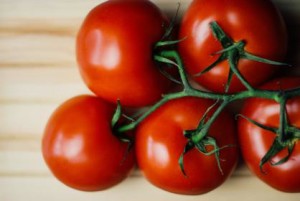 If you have decided to dive in, get some dirt on your hands and grow beautiful, delicious vegetables at home, what’s the next step? After you’ve chosen a location for your garden with good drainage and adequate sun, it’s time to map out your plot. Deciding what kind of plants you include in your plans may begin with what you like, but there are a few other considerations you should include.
If you have decided to dive in, get some dirt on your hands and grow beautiful, delicious vegetables at home, what’s the next step? After you’ve chosen a location for your garden with good drainage and adequate sun, it’s time to map out your plot. Deciding what kind of plants you include in your plans may begin with what you like, but there are a few other considerations you should include.
The taste of a ripe, red tomato: This vision of tasting fresh, flavorful tomatoes at dinner is often what spurs people to try their first vegetable garden. It is important to include plants that you want to eat in your backyard plot. If you have small children that aren’t big vegetable fans, planting some items that they do tend to eat can help them transition to other vegetables that they’ve helped weed and harvest. A kid that puts up with green beans may suddenly love them when he has plucked them from the garden outside his bedroom window.
Getting the most return: If you’re limited on space, either because you live in an urban setting or because most of your yard might be shady, it’s good to think about what kind of plants will give you the best yield for the space. Corn, for instance, takes up a lot of space to get the necessary cross-pollination, while plants like tomatoes or strawberries can be planted in a container on a balcony or in a hanging bag.
Consider what you can’t get: Maybe you live close to a thriving farmer’s market where you have access to locally-grown products. It’s a good idea to think about what you don’t tend to see stocked there and plant vegetables that are harder to get in your area.
Determine what your goals are: Another consideration is whether you would like to put some fresh loose-leaf lettuce on the table this summer, or you are canning and freezing vegetables for the entire year. Maybe you’d like to plant some squash with hard flesh, like butternut or spaghetti, that can last for months in a cool, dry place. You can also stagger your planting of items like lettuce to enjoy them for many months, if you’re not quite ready to dive into canning and preserving.
Think about whether you’ll be around: If you take long vacations, green beans and loose-leaf lettuce may not be ideal, because you may miss their harvest time. You can ask a neighbor or friend to come over and enjoy your fresh vegetables, or you can think about planning your garden harvest around your travel.
All these decisions can play a role in what kinds of plants you choose, but ultimately, the answer lies in what will help you enjoy gardening.
When you’re planning your garden, be sure to include Kincaid Plant Markers to help you identify your plants and keep your garden organized. We have a full selection that resist rust and are made for a lifetime of gardening.
Four Gardening Tips for Growing Lettuce Indoors
Gardening Tips for Enjoying Homegrown Lettuce All Year Round
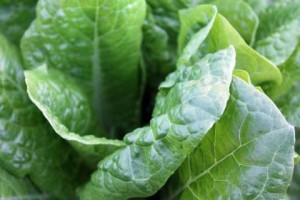 Fresh, homegrown lettuce is one of the reasons vegetable gardeners love what they do. It’s flavorful, it’s much less expensive and there’s a lot of fun in seeing your own lettuce on the dinner table. In the winter months, you may need to get more creative with these gardening tips to enjoy homegrown lettuce year round.
Fresh, homegrown lettuce is one of the reasons vegetable gardeners love what they do. It’s flavorful, it’s much less expensive and there’s a lot of fun in seeing your own lettuce on the dinner table. In the winter months, you may need to get more creative with these gardening tips to enjoy homegrown lettuce year round.
There are multiple ways to grow lettuce indoors, and some of them are both clever and offer aesthetic appeal:
Put your lettuce to work. Did you know that you can cut the base off a head of romaine and use it to grow new lettuce? The next time you use a head of romaine, keep the bottom of the head, place it in warm water and install it near a sunny window. Within a few days, you should see some new growth sprouting up from the lettuce head. After about a week, transfer the base to a pot of soil, leaving the new growth uncovered, and watch as your romaine lettuce grows full-size leaves. It’s possible that you could keep the same head of romaine producing all winter long.
Grow it in a flower pot. Sow some lettuce seeds in a pot by filling a decorative pot three-quarters full of soil, then add the seeds. Top with more soil, and then place near a sunny window and water as needed. You’ll need to thin the lettuce leaves after germination, but with this method and a few pots that you stagger with timing, you could enjoy fresh lettuce throughout the winter months.
Go mobile. If you don’t have an ample windowsill for growing lettuce, consider creating a mobile garden, where you’ll plant lettuce in a little-wheeled cart. This allows you to move your lettuce plantings where it’s convenient. Keep in mind that you can choose a cart that matches your décor, opting for wood or painted metal versions to go with your style.
Add grow lights. You may live in a climate that simply doesn’t have enough sun during the winter to make indoor lettuce growing possible. Using grow lights is one of the best gardening tips because it works for a lot of different indoor gardening projects. Dedicate a corner of your kitchen to growing indoor vegetables and herbs and station your grow lights to give them plenty of artificial sunlight.
Whether you’re growing loose leaf, spinach, romaine or iceberg, it’s a good idea to label your plants for individualized care. Check out Kincaid Plant Markers and give your indoor lettuce garden the benefits of organization and an attractive presentation.
Do You Want to Start Gardening at Home but Aren’t Sure Where to Start?
Get Started Gardening at Home With These Easy to Grow Plants
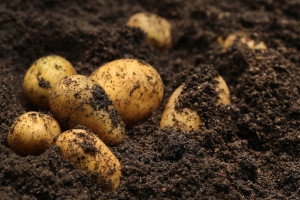 Just a few bites of homegrown tomatoes, or watching a neighbor pick his dinner from his backyard and it’s easy to catch the gardening bug. You may be sobered with thoughts of endless weeding and pest control, but gardening at home is pretty simple when you start with the right selection of plants. Here are 10 easy to grow plants you can use in your first garden and experience success right away:
Just a few bites of homegrown tomatoes, or watching a neighbor pick his dinner from his backyard and it’s easy to catch the gardening bug. You may be sobered with thoughts of endless weeding and pest control, but gardening at home is pretty simple when you start with the right selection of plants. Here are 10 easy to grow plants you can use in your first garden and experience success right away:
- Radishes: These peppery little plants provide a zing to salads or can be tasty eaten on their own while you’re working in your garden. This is a great first crop because even if you only grow radishes your first year, you’ll enjoy them and be inspired to get more adventurous next year.
- Loose leaf greens: Sow a row of salad greens and you’ll be picking your dinner in just a few weeks. Stagger your seed planting to get a steady supply of salad greens, and use a combination of spinach and other varieties to make your salads more interesting.
- Green beans: These are easy to grow and are a great choice for getting kids interested in gardening. Even the pickiest eaters often let a green bean or two onto their plates, and you’ll see them eat more when they come from their own garden.
- Onions: Start small, and enjoy the greens even if you aren’t successful at harvesting bulbs. Sometimes you can cultivate onions to come back year after year for a delicious salad topping.
- Strawberries: These are surprisingly hardy and in a weed-free environment, you’ll love having berries year after year. Choose a bare-root plant for adding into your garden in early spring.
- Peppers: Whether you prefer hot or bell peppers, these easy-to-grow plants will liven up your garden with vibrant colors and add flavor to your cooking. Choose a variety of colors and types to keep color popping all growing season.
- Bush zucchini: This type of zucchini takes up less room than others, and you’ll only have to put in a few plants to get a great crop.
- Tomatoes: Countless people have begun gardening at home just for the taste of homegrown tomatoes. Share with friends and can the rest, but just be sure to plant plenty of tomatoes.
- Basil: Herbs are among the easiest plants to grow, but if you’re planting tomatoes, choose basil to complement the taste.
- Potatoes: This hardy staple is easy to grow and easy to store if you have a dry, cool spot. Plant in the early spring from whole or cut sections of potato.
Gardening at home provides hours of satisfying work that is even more rewarding when you harvest your bumper crop. Keep all your plants organized in neat rows and identified with Kincaid Plant Markers. You’ll use them year after year!
How to Identify Herbs for an Early Spring Garden
Identify Herbs That Will do Well in the Cooler Temperatures of Spring
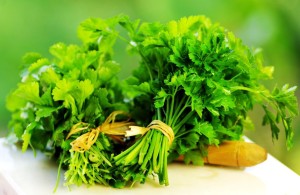 It’s nearly time to begin work on a spring garden, and you can certainly get started now with considering your earliest planting. Identify herbs for an early spring garden, and you’ll be snipping basil for your homemade pasta sauce before you know it. Take a look at some of the best choices for your early planting:
It’s nearly time to begin work on a spring garden, and you can certainly get started now with considering your earliest planting. Identify herbs for an early spring garden, and you’ll be snipping basil for your homemade pasta sauce before you know it. Take a look at some of the best choices for your early planting:
Basil: This is an annual plant that requires a new start every year, but it’s also a popular choice because it’s so easy to use in cooking. You’ll need a sunny spot for planting, but you can have a lot of fun deciding which of the many varieties of basil you’ll choose. Lettuce leaf basil is big enough to take the place of lettuce on a sandwich and add a big kick of flavor. Cinnamon or lemon basil is delicious when added to teas. Sweet or Italian basil are your best choices for everyday cooking.
Cilantro: Start planting cilantro as soon as the weather warms up, and sow seeds every two weeks for an ongoing supply of this flavorful herb. It will taste great in your favorite Mexican or Asian dishes, and the seeds from cilantro, called coriander, are another seasoning you may enjoy using in your kitchen. Cilantro is easy to grow because it can thrive in a variety of soil types and it does well with full or partial sun.
Chives: This perennial plant is one that can dish out a lot of flavor to a variety of dishes. From seasoning chicken to topping a baked potato or salad, there are endless ways to use chives. They prefer to be in the sun, and their purple flowers make them aesthetically pleasing, as well as fun to eat.
Nasturtium: When you identify herbs for your spring garden, don’t limit yourself to the most common. Nasturtium is one of the more exciting early herbs that you can plant because they have large orange-yellow blossoms that will steal the show in your garden. Both the flowers and leaves are edible, with a peppery taste. Even better, the flowers bloom all summer long, so you can enjoy the view and the taste throughout the season.
With spring right around the corner, it’s time to identify herbs for fresh, flavorful cooking. Once you’ve chosen your plantings, label them with Kincaid Plant Markers. Made for a lifetime of gardening, our high-quality plant markers will help you provide the individualized care each of your plants requires.
